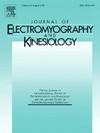Acute effects of different muscle fatigue conditions during strength training on localized muscle bioimpedance in women
IF 2.3
4区 医学
Q3 NEUROSCIENCES
引用次数: 0
Abstract
This study aims to compare the localized muscle bioimpedance (ML-BIA) responses under different muscle fatigue conditions during strength training (ST). Twelve women participated in the study, which followed a crossover, counterbalanced, and randomized design. The experimental sessions were conducted using a 45° leg press machine, consisting of two conditions: a session until muscle failure (MF) and a session with no muscle failure (NMF). ML-BIA was assessed before the sessions, immediately after all sets were completed, and 20 and 30 min post-sessions. The ML-BIA measures of resistance (R), reactance (XC), and phase angle (PA) of the quadriceps were obtained. The countermovement Jump (CMJ) was assessed before and after both conditions. Repeated measures analysis of variance was used to compare conditions, with a significance level set at p < 0.05. In the CMJ test, significant reductions in jump height and power were observed only in the MF condition (p < 0.001). PA showed significant reductions compared to rest only in the MF condition (p < 0.001), with reductions maintained up to 30 min after the session. Our data showed that ML-BIA parameters respond differently under varying fatigue conditions, with PA decreasing only in the higher fatigue condition.
力量训练中不同肌肉疲劳状态对女性局部肌肉生物阻抗的急性影响
本研究旨在比较力量训练(ST)中不同肌肉疲劳状态下的局部肌肉生物阻抗(ML-BIA)反应。12名女性参与了这项研究,该研究遵循交叉、平衡和随机设计。实验使用45°腿压机进行,包括两种情况:一种是直到肌肉衰竭(MF),另一种是没有肌肉衰竭(NMF)。在训练前、所有训练完成后以及训练后20和30分钟分别对ML-BIA进行评估。ML-BIA测量了股四头肌的电阻(R)、电抗(XC)和相位角(PA)。对两种条件前后的反动作跳跃(CMJ)进行评估。采用重复测量方差分析比较条件,显著性水平设置为p <; 0.05。在CMJ测试中,仅在MF条件下观察到跳跃高度和力量的显著降低(p < 0.001)。与仅在MF条件下休息相比,PA表现出显著的减少(p < 0.001),这种减少在会话后持续30分钟。我们的数据表明,ML-BIA参数在不同的疲劳状态下响应不同,只有在高疲劳状态下PA才会下降。
本文章由计算机程序翻译,如有差异,请以英文原文为准。
求助全文
约1分钟内获得全文
求助全文
来源期刊
CiteScore
4.70
自引率
8.00%
发文量
70
审稿时长
74 days
期刊介绍:
Journal of Electromyography & Kinesiology is the primary source for outstanding original articles on the study of human movement from muscle contraction via its motor units and sensory system to integrated motion through mechanical and electrical detection techniques.
As the official publication of the International Society of Electrophysiology and Kinesiology, the journal is dedicated to publishing the best work in all areas of electromyography and kinesiology, including: control of movement, muscle fatigue, muscle and nerve properties, joint biomechanics and electrical stimulation. Applications in rehabilitation, sports & exercise, motion analysis, ergonomics, alternative & complimentary medicine, measures of human performance and technical articles on electromyographic signal processing are welcome.

 求助内容:
求助内容: 应助结果提醒方式:
应助结果提醒方式:


